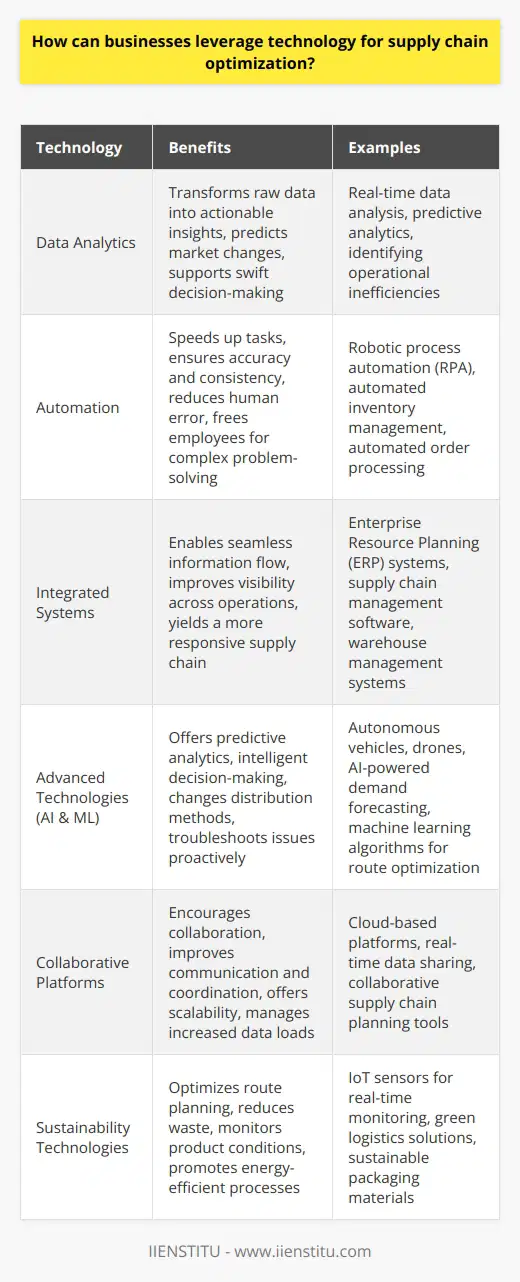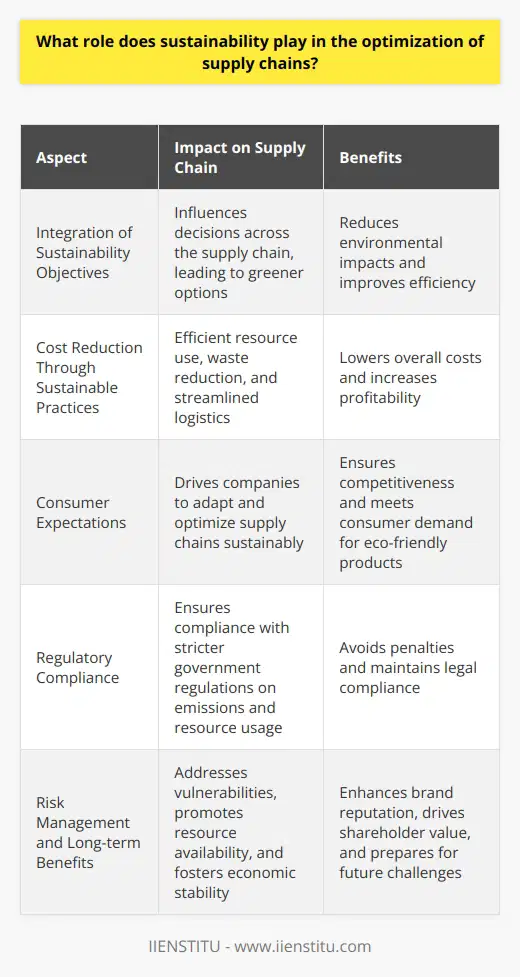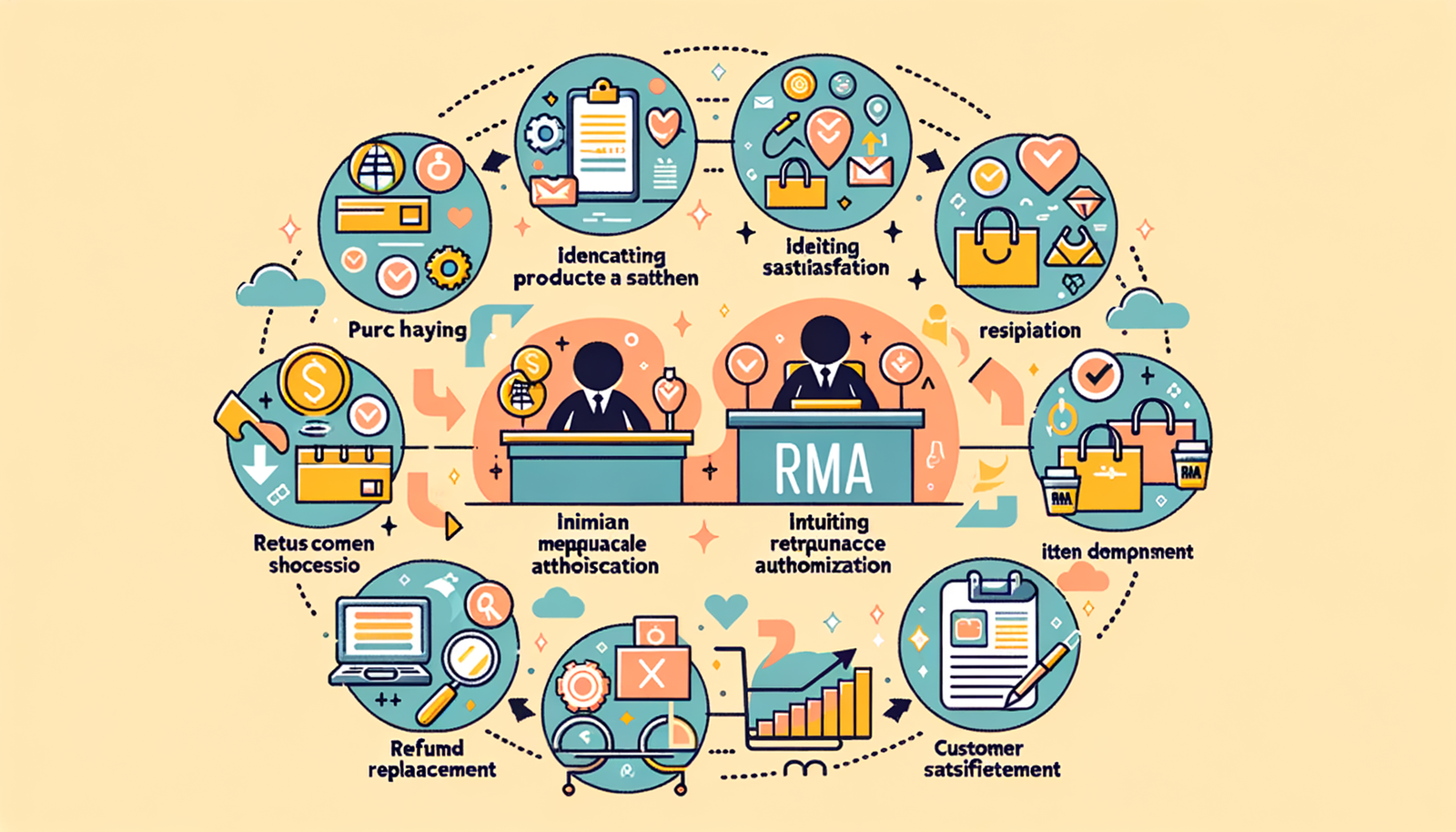
The dynamism of modern commerce has rendered supply chain optimization an imperative for businesses aiming to preserve competitive advantage. At its core, supply chain optimization encompasses the systematic and strategic realignment of end-to-end business operations, from procurement of raw materials to product delivery. Its importance cannot be overstated; as customer expectations rise and markets become more volatile, an optimized supply chain can mean the difference between thriving and merely surviving in today's business landscape.
Understanding the Basics of Supply Chain Optimization
Definition and Function of Supply Chain
The term supply chain refers to a network of interconnected stakeholders, activities, resources, and technologies that cooperate to transform raw materials into final products for end consumers. This network obliges meticulous strategies to ensure fluidity and efficiency, demanding a holistic approach that simultaneously addresses the functional intricacies and the overarching business objectives.
The function of the supply chain is, therefore, to seamlessly execute these transformations while minimizing costs and maximizing value at each juncture.
Interactions and Key Components of the Supply Chain
Understanding a supply chain's functionality necessitates dissecting its constituent elements into three principal categories: procurement, production, and distribution. Procurement pertains to sourcing raw materials and services necessary for production, necessitating a nuanced intelligence of market trends and supplier capabilities.
Production, conversely, is the transformational engine of the supply chain, where raw materials are converted into finished goods through a series of processes that require optimization to inhibit inefficiencies. In the realm of distribution, logistics come to the forefront, embracing the necessity to deliver products to customers timely and cost-effectively, which can pose significant complexities in an era punctuated by globalization.
Initial Concept of Optimization in a Supply Chain
Originating from a desire to eliminate waste and heighten responsiveness, the preliminary notion of supply chain optimization involved streamlining processes to expedite flow and lower inventory holdings. While this foundational concept remains valid, present-day optimization strategies delve into sophisticated realms like data analytics and cross-functional synergies, extending the purview of optimization from mere cost reduction to creating value and strategic differentiation.
How To Reduce Transportation Costs İn Supply Chain Management
Long Tail Keyword For Maximizing Value Through Logistics Management
Importance of Supply Chain Optimization
Necessity and Benefits of an Optimized Supply Chain
An optimized supply chain is indispensable not only for maintaining cost-effectiveness but also for bolstering a company's ability to adapt to market fluctuations and customer demands. The benefits are vast, encompassing improved operational efficiency, reduced lead times, enhanced product quality, and heightened customer satisfaction. By optimizing their supply chains, firms anchor a sustainable competitive edge that directly contributes to their bottom line.
Role in Boosting Efficiency and Mitigating Risks
Supply chain optimization is an essential determinant in risk mitigation strategies. It empowers businesses to preempt potential disruptions through scenario planning and to respond dynamically to unforeseen events, ensuring continuity of operations. In bridging efficiency and resilience, supply chain optimization serves as a fulcrum for business stability even amid uncertain market terrains.
Contribution to Better Customer Service and Financial Performance
At the intersection of supply chain optimization and customer service lies the promise of expedited deliveries and tailored product assortments—key factors influencing customer loyalty and satisfaction. Such meticulous attention to customer service invariably translates into robust financial performance, spurred by improved sales, reduced operational costs, and strategic inventory management.
Key Strategies for Supply Chain Optimization
Technology and Digitalization
In the pursuit of supply chain optimization, embracing technology is nonnegotiable. The application of Artificial Intelligence (AI) and Machine Learning (ML) renders predictive powers, automating and refining decision-making across the supply chain. The integration of the Internet of Things (IoT) further sketches a network of smart devices that gather and exchange real-time data, imbuing the supply chain with unprecedented visibility and responsiveness. Concrete examples of such technologies in action include AI-driven demand forecasting and IoT-enabled track-and-trace systems, which collectively revolutionize supply chain management.
Logistics Management İn Supply Chain Efficiency And Customer Service
Order Status İnformation For Customer Satisfaction İn Logistics Management
Most Searched Long Tail Keyword For İnternational Trade Tariff Codes
Collaboration and Integration
Internal collaboration among various departments within an organization enhances information flow and breaks down silos that could otherwise impede supply chain fluidity. Equally crucial is the promotion of external alliances with suppliers and customers to craft a more responsive and robust supply chain. Such integrative efforts fuse disparate segments into a cohesive unit, equipped to address the complexities of contemporary supply demands.
Demand and Supply Management
Managing the delicate balance between demand and supply stands at the core of supply chain optimization. Predominantly, the importance of accurate demand forecasting cannot be overemphasized; it underpins inventory strategies ensuring that a firm is neither overstocked nor underprepared. Conversely, adept supply planning shores up the supply chain against potential shortages, carefully calibrating procurement and production to harmonize with market cadences.
Challenges and Solutions in Supply Chain Optimization
Common Difficulties Faced in Optimizing Supply Chains
Even with the finest strategies, firms may encounter roadblocks in supply chain optimization. Such obstacles may range from volatile market demands to internal resistance against organizational changes. Technological integration issues can also arise, hampering the fluid operation and data sharing necessary for an agile supply chain.
Effective Methodologies and Solutions to Overcome Such Challenges
Key to circumventing these hurdles are methodologies that emphasize flexibility, such as agile and lean supply chain principles. Adopting a continuous improvement mindset ensures that supply chains can adapt to change organically. Bolstering this is the need for ongoing employee education, including participation in logistics courses and online courses with certificates, to ensure the workforce is proficient in the skills necessary for contemporary supply chain management.
Example of Overcoming a Supply Chain Optimization Challenge
Consider the case where a prominent retailer experienced chronic out-of-stock situations during peak seasons. By leveraging advanced demand forecasting tools and refining their supplier engagement model, the retailer managed to harmonize their inventory levels with consumption patterns, thereby curbing stockouts and boosting customer satisfaction.
Future of Supply Chain Optimization
Potential Advancements and Improvements in the Field
As we gaze toward the horizon of supply chain optimization, advancements beckon in the form of deeper analytical capabilities, increased automation, and the ascendancy of sustainability considerations within the supply chain. Continued refinement and adoption of cutting-edge technologies will see supply chains becoming more predictive, adaptive, and environmentally conscious.
Influence of Evolving Technologies and Business Practices
Emerging technologies like blockchain and 5G are set to radically transform supply chain transparency and speed, while evolving business practices emphasize the nexus of supply chain strategy with overarching corporate sustainability objectives. This symbiosis primes the enterprise for both ethical stewardship and operational excellence.
Significance and Need of Continuous Optimization
As businesses fluctuate in an impermanent global environment, the significance and need for continuous supply chain optimization become inarguably manifest. The aim is to not only respond to changes reactively but to architect supply chains that are intrinsically resilient and innately predisposed to evolution.
We conclude with a reinforcement of the unwavering importance of supply chain optimization and the strategies that underpin it. In an age where customer centrality and operational agility govern success, an optimized supply chain is not a luxury but a necessity. With the bedrock of continuous optimization and resilience against the backdrop of an evolving business milieu, supply chains will continue to serve as the backbone of efficient, responsive, and sustainable commerce.
Frequently Asked Questions
What are the key elements for effectively optimizing a supply chain operation?
Key Elements for Supply Chain Optimization
Understand Demand Patterns
Effective supply chain operations start with demand understanding. Companies must analyze market trends. This enables accurate forecasting. Demand forecasting guides inventory management. It prevents both shortages and excesses.
Streamline Processes
Efficiency lies in streamlined processes. Identify bottlenecks. Eliminate them. Lean principles often apply here. They ensure smooth operations. This reduces waste. And it improves speed.
Implement Technology Solutions
Technology drives modern supply chains. It enables better data visibility. Real-time tracking becomes possible. Advanced analytics can predict disruptions. Automation improves efficiency. Robotics and AI offer significant help.
Foster Supplier Relationships
Strong supplier partnerships are crucial. Mutually beneficial relationships aid performance. They also improve reliability. Trust between parties leads to better collaboration. Negotiate terms that support both sides.
Invest in Training
Well-trained staff can pivot quickly. They solve problems faster. Ongoing training keeps them sharp. It ensures teams can handle new technology. And adapt to changing conditions.
Monitor KPIs
Key Performance Indicators (KPIs) track success. They highlight areas needing improvement. Regular monitoring keeps operations aligned. It allows for timely adjustments. Choose KPIs that reflect your goals.
Emphasize Sustainability
Sustainability is no longer optional. Efficient supply chains consider environmental impacts. They engage in ethical sourcing. And they aim for resource conservation. Sustainable practices often lead to cost savings.
Be Adaptable to Change
Supply chains must remain adaptable. The market is dynamic. Changes occur rapidly. Agility enables quick responses to disruption. It also allows for seizing new opportunities.
Continually Improve
Continuous improvement is a mindset. Always look for ways to enhance operations. Gather feedback. Learn from mistakes. Implement improvements methodically. This ensures long-term success.
Supply chain optimization is multifaceted. It requires careful planning. And diligent execution. Incorporating these elements paves the way. It creates resilient, efficient, and sustainable supply chains.

How can businesses leverage technology for supply chain optimization?
Supply Chain Optimization Through Technology
Businesses must adapt swiftly in the technology era. Competitive markets require supply chain efficiency. Technology offers unprecedented optimization opportunities. Key strategies involve leveraging data analytics, automating processes, and integrating systems.
Embrace Data Analytics
Data is king in supply chain management. Analytics transform raw data into actionable insights. Companies predict market changes effectively. Real-time data supports swift decision-making. Operational inefficiencies become easier to identify. Managers use insights to make strategic adjustments.
Invest in Automation
Automation speeds up supply chain tasks. It ensures accuracy and consistency. Technologies such as robotic process automation are vital. They handle repetitive, time-consuming tasks with ease. This reduces human error considerably. It frees employees for complex problem-solving roles.
Integrate Systems
Siloed information hampers cohesive working. Integrated systems enable seamless information flow. Technologies such as Enterprise Resource Planning (ERP) systems are crucial. They connect procurement, production, distribution, and retail. This alignment yields a more responsive supply chain. Visibility improves across all operations.
Advanced Technologies
Artificial Intelligence (AI) and Machine Learning (ML) are transforming supply chains. They offer predictive analytics and intelligent decision-making. Autonomous vehicles and drones change distribution methods. They cut costs and delivery times. AI systems troubleshoot issues before they escalate. This proactivity avoids costly disruptions.
Collaborative Platforms
Cloud-based platforms encourage collaboration. All stakeholders access the same real-time data. This improves communication and coordination. Supply chain partners adapt to changes collectively. Cloud services also offer scalability. Businesses manage increased data loads without difficulty.
Sustainability Through Technology
Tech-driven supply chains are more sustainable. They optimize route planning and reduce waste. Sensors monitor product conditions during transit. This helps in reducing spoilage. Energy-efficient processes emerge from tech optimizations. These changes benefit the environment and the bottom line.
In conclusion, businesses reach new efficiency heights by leveraging technology. Optimization becomes less a challenge, more an opportunity. Tech investments today shape the resilient supply chains of tomorrow.

What role does sustainability play in the optimization of supply chains?
Sustainability in Supply Chain Optimization
In recent years, sustainability has become critical. It shapes modern supply chains. Sustainability strategies improve efficiency. They aim to reduce environmental impacts. Supply chain optimization now requires a sustainable approach.
Integration of Sustainability Objectives
Supply chains must integrate sustainability. They consider various factors. This involves energy consumption. It involves waste management. These factors influence decisions across the supply chain. They often lead manufacturers to choose greener options.
Cost Reduction Through Sustainable Practices
Sustainability can lead to cost savings. Efficient use of resources reduces expenses. Less waste means lower disposal costs. Streamlined logistics cut down fuel consumption. All these reductions lower overall costs.
Consumer Expectations Drive Change
Consumers now expect sustainability. They prefer eco-friendly products. This forces companies to adapt. They must optimize their supply chains sustainably. Companies addressing this demand stay competitive.
Regulatory Compliance
Governments are imposing stricter regulations. These concern carbon emissions. They concern resource usage. Supply chains must comply. Sustainable optimization ensures compliance. It avoids penalties.
Risk Management
Sustainability helps in managing risks. It addresses vulnerabilities. It prompts companies to diversify. It encourages local sourcing. This reduces dependency. It makes supply chains more resilient.
Long-term Benefits
Sustainable supply chains offer long-term benefits. They promote resource availability. They support community health. They foster economic stability. These positive outcomes enhance brand reputation. They drive shareholder value.
Sustainability Metrics
Companies track sustainability metrics. They measure carbon footprint. They measure water usage. These metrics help in strategic planning. They monitor progress. They drive continuous improvement.
Innovation and Collaboration
Innovation is key to sustainable optimization. Companies invest in new technologies. These technologies often increase efficiency. Collaboration also plays a role. Partners share best practices. They work together on sustainability initiatives.
Conclusion
In conclusion, sustainability is indispensable. It transforms supply chains. It promotes efficiency, savings, and resilience. Companies embracing sustainability thrive. They meet current needs. They prepare for future challenges. This commitment nets them long-term success.



